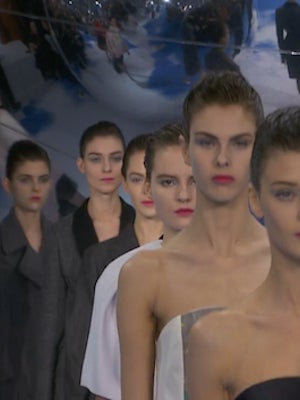
The topic of racial diversity is always one that the fashion world has gingerly broached, perhaps because high fashion seems to be so bad at being all-inclusive. Runway statistics from the fall/winter '13 Fashion Month reveal that a staggering 90% of the models sent down the runways were white. This isn't a new problem — it's an old one that doesn't seem to be getting any better. And the most recent designer-shaming calls out Raf Simons' particularly whitewashed runway show at Dior.
"I feel the Dior cast is just so pointedly white that it feels deliberate," James Scully, the casting director for Tom Ford and Lanvin says. "I watch that show and it bothers me — I almost can't even concentrate on the clothes because of the cast. And recently they're changing from a very diverse, worldwide, multicultural cast to just a very Germanic-looking white girl. Natalie Portman could complain that John Galliano was a racist, but I feel Raf Simons sends the same message. I don't know what the difference is."
AdvertisementADVERTISEMENT
Another casting director, Leila Ananna, offers a different perspective. She believes that, "a model is a model and that's it. To me, if we want to talk about diversity, it's about the model and not the color of their skin." She claims that having an Asian model or black model walk down the runway to just have them there can often receive the same backlash as white-washing the cast. She suggests that people can see through "tokenism."
True, Raf doesn't cast the shows himself, but he still has to approve the lineup...and he is also the current face of the Dior creative. Based on numbers alone, Simons' Dior is considerably less diverse than Galliano's, whose shows were quite ethnically expansive — often, they were one of the most varied of the season — during his reign. Perhaps this is because Simons employs the same casting directors, Maida Gregori Boina and Rami Fernandes, responsible for the notoriously all-white model ensembles for Jil Sander and Calvin Klein. However, we need to consider the idea that the practices of runway fashion isn't the only thing we need to be examining.

Some believe that this problem extends beyond the runway and into our everyday consumerism. Jada Pinkett-Smith took to her Facebook Monday with two fictional magazine covers, one featuring Queen Latifah on the cover of Cosmo and Charlize Theron covering Essence. She proposed that, if the black community wants to see more diversity in mainstream consumerism, they should allow white women to cover "black" magazines. "If we ask our white sisters, who tend to be the guardians of the covers of mainstream magazines, to consider women of color to grace these covers, should we not offer the same consideration to white women to grace our covers?"
AdvertisementADVERTISEMENT
It seems that Smith and Leila Ananna share a similar viewpoint. The question of racial diversity in fashion and the consumer world is deeper than puzzling over why Dior's show was pretty white or why Ebony won't feature a white woman on the cover. It's a question of how we perceive each other: Do we first see a woman as a woman or do we see race first and then her womanhood? Do we see Jada Pinkett-Smith as a women whose skin is dark or do we see her as a black woman? Is Jourdan Dunn a model who happens to be black or is she a black model?
We understand that these questions aren't easy, but they are important to examine because such bias appears to be fundamentally built into the ways identity has been communicated on a larger level. But for a more localized conversation, it begs a question: Should fashion attempt to lead the way? We really don't have the answers, so we'll leave you with this thought: It has always been fashion's prerogative to push boundaries and raise questions about the way we consider our personal aesthetics. As such, it might be our duty to always be pushing to change or question identity politics. (Fashionista)
Photos: Courtesy of Dior; Facebook/Jada Pinkett-Smith.
AdvertisementADVERTISEMENT






